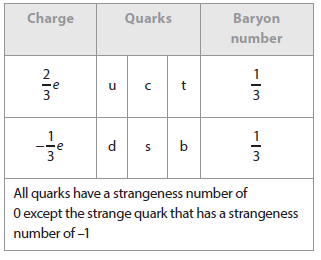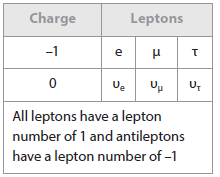Understandings:
- Quarks, leptons and their antiparticles
- Hadrons, baryons and mesons
- The conservation laws of charge, baryon number, lepton number and strangeness
- The nature and range of the strong nuclear force, weak nuclear force and electromagnetic force
- Exchange particles
- Feynman diagrams
- Confinement
- The Higgs boson
Applications and skills:
- Describing the Rutherford-Geiger-Marsden experiment that led to the discovery of the nucleus
- Applying conservation laws in particle reactions
- Describing protons and neutrons in terms of quarks
- Comparing the interaction strengths of the fundamental forces, including gravity
- Describing the mediation of the fundamental forces through exchange particles
- Sketching and interpreting simple Feynman diagrams
- Describing why free quarks are not observed
|
International-mindedness:
- Research into particle physics requires ever-increasing funding, leading to debates in governments and international research organizations on the fair allocation of precious financial resources
Theory of knowledge:
- Does the belief in the existence of fundamental particles mean that it is justifiable to see physics as being more important than other areas of knowledge?
Utilization:
- An understanding of particle physics is needed to determine the final fate of the universe (see Physics option sub-topics D.3 and D.4
Aims:
- Aim 1: the research that deals with the fundamental structure of matter is international in nature and is a challenging and stimulating adventure for those who take part
- Aim 4: particle physics involves the analysis and evaluation of very large amounts of data
- Aim 6: students could investigate the scattering angle of alpha particles as a function of the aiming error, or the minimum distance of approach as a function of the initial kinetic energy of the alpha particle
- Aim 8: scientific and government organizations are asked if the funding for particle physics research could be spent on other research or social needs
|



